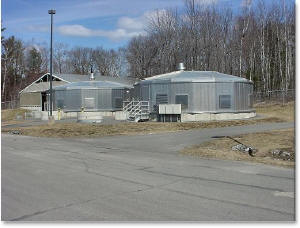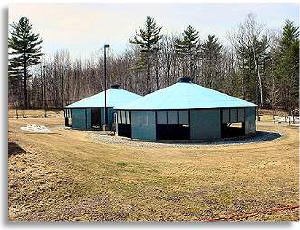![]()
Lincoln, Maine
![]()
| Operations |
| Biosolids Utilization |
| Facility Plan |
| EPA CSO Award |
| Facility Staff |
| Links |
Operations -
Lincoln Sanitary District

The wastewater treatment at the Lincoln Sanitary District
facility consists of a dual train, two stage, rotating
biological contactor (RBC) process with primary and secondary
settling, influent screening, aerated grit removal, chlorine gas
disinfection and discharge to the Penobscot River. Treatment
begins with a manually cleaned bar rack followed by aerated grit
chambers with bucket conveyer grit removal to an inline screw
type grit classifier followed by a communitor. When flows exceed
the original design flow of 1.07 MGD but no more than a one hour
peak of 2.8 MGD, another manually cleaned bar rack and a vortex
degritter can be placed in service which can handle an
additional 5.7 MGD during early spring rain and snow melt
events. The flow is then sent to primary clarifiers followed by
air driven rotating biological contactors, secondary clarifiers
and chlorine contact chambers.
Primary sludge is removed from the primary clarifiers and
combined with secondary sludge sloughed off of the RBCs. The
combined sludge is dewatered (two one meter belt presses),
composted and removed for beneficial use as a soil conditioner
and low nitrogen fertilizer.

There are no industrial waste contributors to the facility.
Commercial wastes are limited to discharges from schools, a
hospital, restaurants, a laundromat / dry cleaner, a nursing
home and a car wash. Wastewater is collected utilizing 17.4
miles of sanitary sewers with 11 pump stations. Wastewater is
pumped to the treatment facility from 2 independent pump
stations, Creamery Court Pump Station and Military Road Pump
Station. Wastewater to the plant is a combination of domestic
and commercial discharges. The strength (BOD5 and TSS
concentrations) total load
(BOD5 and TSS daily mass), and
temperature of the wastes are highly variable. This is mostly
due to infiltration and other wet weather flows contributing to
the wastewater.
The original
treatment plant was constructed in 1979 to 1981 with a
subsequent upgrade in 1999. The 1999 upgrade provided new
primary clarifiers and a wet weather grit removal system but did
not address current equipment / process unit operations.